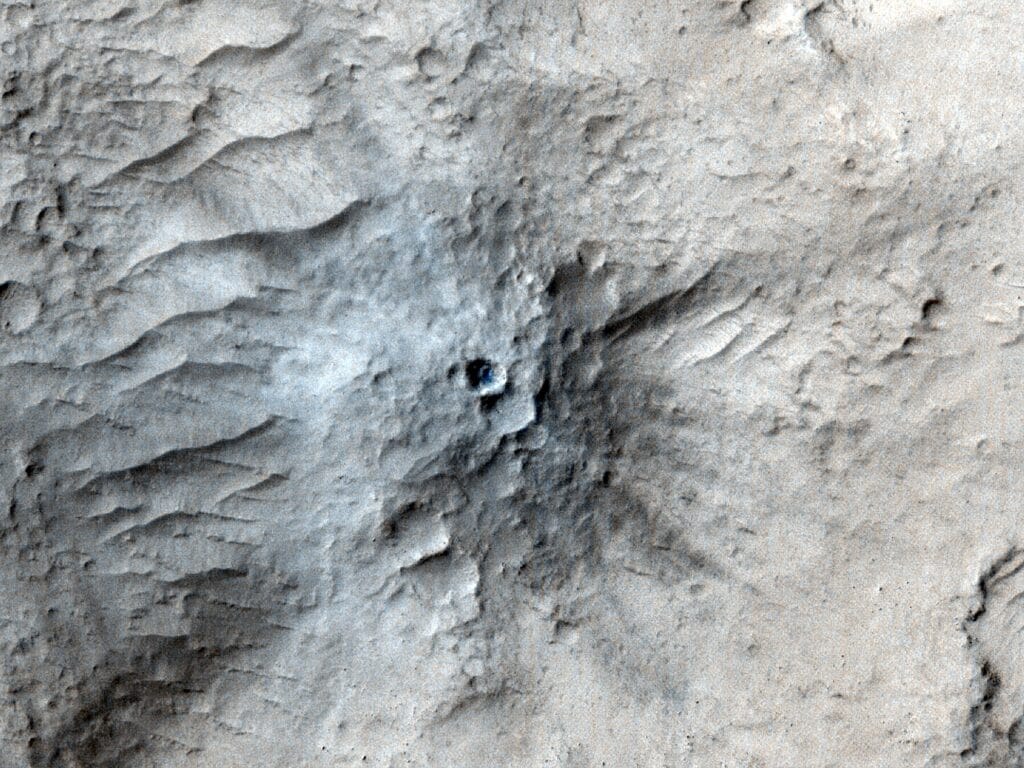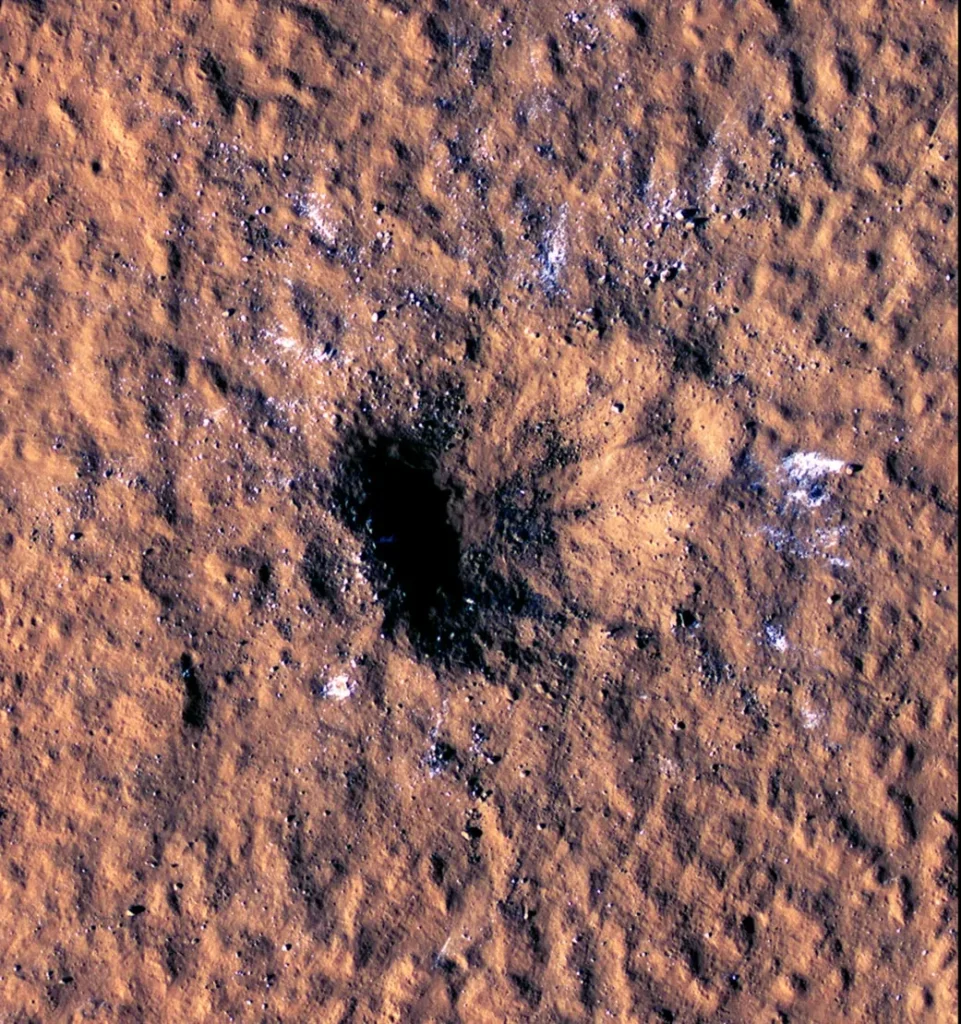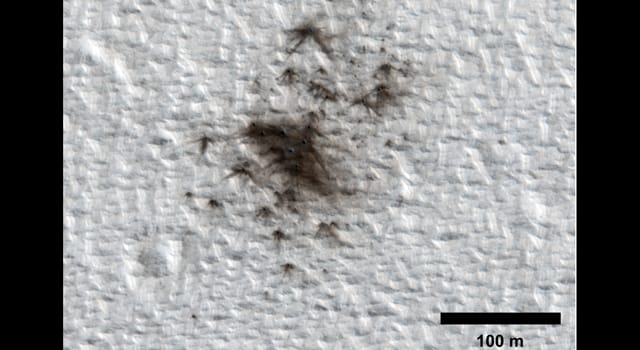
Imagine the Red Planet, our neighboring world in the solar system, suddenly shaken by a powerful collision from space. Scientists have long studied Mars through missions like NASA’s InSight lander, which wrapped up its operations in 2022 after detecting seismic activity from meteoroid strikes. Just recently, in early 2025, researchers using artificial intelligence analyzed data from that mission to uncover how such impacts can disturb layers deep within the planet’s mantle, the semi-solid rock region below the crust. These findings, detailed in a NASA Jet Propulsion Laboratory report on InSight’s deeper marsquake insights, show that Mars faces ongoing bombardment from space rocks, creating fresh craters and sending shockwaves across its surface. This activity highlights how dynamic Mars remains, even without active volcanoes or plate tectonics like on Earth.

Asteroid impacts have shaped Mars over billions of years, leaving behind thousands of craters that tell stories of its ancient history. According to data from NASA’s Mars Reconnaissance Orbiter, which has been imaging the planet since 2006, the surface is dotted with over 200 new small craters formed in recent decades alone. A study published in 2024 in the journal Nature Astronomy, based on InSight’s seismic recordings, estimates that Mars endures between 280 and 360 impacts each year that form craters larger than 8 meters in diameter. This rate, higher than earlier predictions, comes from analyzing high-frequency marsquakes, vibrations in the ground caused by these collisions. Such events remind us that space is not empty but filled with wandering asteroids and meteoroids that can alter planetary landscapes in an instant.
But what if a larger asteroid, say one several kilometers wide, slammed into Mars right now? Would it reshape the planet’s thin atmosphere, trigger global dust storms, or even send debris flying toward Earth?
How Often Do Asteroids Hit Mars?
Asteroids collide with Mars more frequently than with Earth because the Red Planet’s thin atmosphere provides less protection against incoming space rocks. Research from Brown’s University in 2024, using NASA’s InSight data, reveals that the planet experiences around 280 to 360 meteorite impacts annually, each creating craters at least 8 meters across. This figure comes from seismic detections of very-high-frequency marsquakes, which are short, sharp vibrations picked up by sensitive instruments on the lander. For comparison, Earth sees fewer such events because most small asteroids burn up in our denser atmosphere before reaching the ground. On Mars, with an atmospheric density of about 0.015 kg/m³ (mass per cubic meter, roughly 1% of Earth’s), many more survive to hit the surface intact.
Scientists have tracked this impact rate through orbital imaging and ground-based sensors. For instance, a peer-reviewed paper in Science Advances from June 2024 notes that InSight’s seismometer identified eight new craters formed during its mission from 2018 to 2022, some as far as 3,500 kilometers from the lander. These impacts occur randomly across the planet, but areas near the equator, like the Amazonis Planitia region, seem particularly prone due to their exposure. Fun fact: Mars’ two small moons, Phobos and Deimos, may themselves be captured asteroids, adding to the planet’s history of close encounters with space debris. To visualize the frequency, imagine a chart showing yearly impact counts—researchers often reference figures from NASA’s Mars Reconnaissance Orbiter, which has spotted over 1,000 fresh craters since 2006.
This higher bombardment rate means Mars’ surface is constantly evolving. Unlike Earth, where erosion from water and wind quickly erases craters, Mars preserves them for billions of years. A study from Imperial College London, published in Nature Astronomy in 2024, used InSight data to calculate that the global impact flux is 2.6 times higher than previous orbital estimates, accounting for undetected events. If you’re picturing the distribution, think of a map dotted with craters: larger ones, over 100 meters wide, form every few years, while tiny impacts happen daily. These statistics help experts predict risks for future missions, ensuring rovers like Perseverance avoid hazardous zones.
What Would Happen If a Large Asteroid Hit Mars?
A large asteroid striking Mars would unleash tremendous energy, creating a massive crater and ejecting debris high into the atmosphere. Based on simulations from a 2023 NASA study on impact effects, a 1-kilometer-wide asteroid hitting at 15 km/s (kilometers per second, about 54,000 km/h) could form a crater up to 100 kilometers in diameter, with shockwaves rippling through the crust. The thin atmosphere would do little to slow the object, allowing it to penetrate deeply and vaporize rock upon impact, releasing heat equivalent to millions of nuclear bombs. According to findings in a Science Advances article on Martian meteorite source craters, such events could launch fragments into space, some eventually reaching Earth as meteorites.
The immediate aftermath would include a fireball brighter than the Sun, visible from orbit, followed by seismic waves traveling across the planet. NASA’s InSight mission detected a similar but smaller event in December 2021, where a meteoroid created a 150-meter crater and caused a magnitude 4 marsquake, as reported in a 2022 NASA update. For a larger hit, dust and ejecta (thrown-out material) could blanket vast areas, potentially triggering global dust storms that last months. These storms, observed by ESA’s Mars Express since 2003, can raise atmospheric temperatures by 30 degrees Celsius due to absorbed sunlight. Fun example: It’s like throwing flour into the air in a kitchen—the particles linger, obscuring the view.
Long-term effects might alter Mars’ geology. The impact could fracture the crust, exposing subsurface ice, which melts and forms temporary lakes. A 2024 university research from the University of Texas on impact-diverted watersheds suggests that ancient hits reshaped river systems, hinting at how modern ones could do the same if water ice is involved. Uncertainty exists in exact crater depths, with models showing ranges from 10 to 20 kilometers deep for big impacts, depending on the asteroid’s composition—rocky ones create sharper features than icy comets. To help picture this, refer to diagrams in NASA’s impact simulation tools, which illustrate ejecta patterns like rays extending hundreds of kilometers.
How Does Mars’ Thin Atmosphere Affect Asteroid Impacts?
Mars’ atmosphere, composed mainly of carbon dioxide with a surface pressure of just 610 Pascals (about 0.6% of Earth’s), allows asteroids to reach the surface with minimal slowdown. This means smaller objects that would disintegrate on Earth can create craters on Mars. A peer-reviewed study in Icarus from 2022 on meteoroid fragmentation notes that the low density—0.015 to 0.02 kg/m³—results in less atmospheric drag, so impacts happen at higher speeds, around 10-20 km/s. For context, Earth’s thicker air causes most meteoroids under 10 meters to burn up, but on Mars, they hit hard, as evidenced by over 1,000 new craters imaged by NASA’s Mars Reconnaissance Orbiter since 2006.
The atmosphere does play a role in post-impact effects, though. Ejecta from the crash can mix with dust, creating plumes that rise high and spread globally. ESA’s research on Mars Express data, detailed in a 2025 release about a 2021 impact, shows how such events can inject particles into the upper atmosphere, potentially thinning it further over time. Fun fact: During a hit, the incoming asteroid compresses the air ahead, creating a shockwave that heats the gas to thousands of degrees, like a natural furnace. This process, called ablation (material loss due to heat), is less efficient on Mars, preserving more of the asteroid’s mass for crater formation.
Comparisons with Earth highlight the differences. On our planet, dense air creates fireballs and airbursts, like the 2013 Chelyabinsk event. On Mars, with no such buffer, craters form more readily, as confirmed by a 2024 Brown University analysis of InSight seismic data. If visualizing, think of a table: Earth impacts—high fragmentation, fewer craters; Mars impacts—low fragmentation, more craters. Uncertainties in atmospheric models mean impact speeds vary by 10-20%, but recent updates from JAXA’s MMX mission planning emphasize monitoring for better predictions.
What Do Recent Impact Craters on Mars Tell Us?
Recent craters provide clues about Mars’ interior and past climate. The largest fresh ones, over 130 meters wide, formed in late 2021 and were studied in a 2022 Science paper using orbital images from NASA’s Mars Reconnaissance Orbiter. These features expose bright ice layers beneath the dusty surface, suggesting water resources for future exploration. One crater, imaged in the Tempe Terra region, revealed blue-toned ejecta, indicating subsurface materials unaltered by weathering, as per a NASA InSight stunning meteoroid impact page.

These craters also help date the surface. By counting new ones, scientists estimate resurfacing rates—Mars adds about 200 small craters yearly, per a 2013 JPL study updated in 2024. Fun example: It’s like nature’s clock, where each crater marks a timestamp. Seismic data from InSight shows impacts can probe deep, with waves reaching 100 kilometers into the mantle, revealing a less dense core than expected.
- Crater sizes range from 8 to 150 meters for recent events.
- Ejecta patterns show rays up to 40 kilometers long.
- Ice exposure confirms polar reserves extend equatorward.
A 2024 study from Oxford University on two major 2021 impacts used InSight to map subsurface rocks “shocked” by the force, altering their structure like compressed sponges.
Could an Asteroid Impact Change Mars’ Climate?
An asteroid hit could temporarily warm Mars by releasing greenhouse gases and dust. Models from a 2019 JPL study suggest that if the atmosphere was hydrogen-rich in the past, impacts produced ingredients for life, but today, with mostly CO2, effects are dust-driven. A large impact might loft dust, blocking sunlight and cooling the surface initially, then warming as particles absorb heat, per ESA’s Mars Express observations of storm aftermaths.
The thin atmosphere means changes are short-lived, lasting weeks to months. Uncertainty in dust settling times—ranging from 1 to 6 months—comes from variable wind patterns. Fun fact: It’s similar to volcanic eruptions on Earth, but without lava. A 2024 peer-reviewed paper in Astrobiology discusses how ancient impacts may have created habitable zones by melting ice.
How Do Scientists Detect Asteroid Impacts on Mars?
Detection combines orbital cameras and seismic sensors. NASA’s InSight lander, operational until 2022, “heard” impacts via marsquakes, with a 2025 AI analysis revealing deeper effects. The Mars Reconnaissance Orbiter uses its HiRISE camera to spot new dark spots, confirming over 1,000 craters since 2006, as in a JPL space rock impacts count.

ESA’s Mars Express contributes with radar, detecting subsurface changes post-impact. Methods include:
- Seismic wave analysis for location.
- Before-after imaging for verification.
- AI for pattern recognition in data.
Recent advancements, like 2024 studies using InSight, double the known rate.
What Size Asteroid Would Create a Massive Crater on Mars?
A 5-kilometer asteroid could form a 500-kilometer crater, based on scaling laws from a 2022 university model. Smaller ones, 100 meters wide, create 10-kilometer craters at 15 km/s. Factors like angle affect size—shallow hits make elongated shapes, per NASA’s impact study.
For visualization, a table might show:
- 10m asteroid: 1km crater.
- 1km: 100km crater.
- 10km: 1000km+ (basin).
Uncertainty: ±20% due to rock strength variations.
Would an Asteroid Hit Affect Future Mars Missions?
Debris from impacts could pose risks to orbiters and landers. A 2024 simulation of DART ejecta reaching Mars warns of micrometeoroid showers. Dust storms might delay landings, as seen in past missions.
Planning includes hazard maps from NASA’s orbiter data.
How Does Mars’ Gravity Influence Impact Effects?
Mars’ gravity, 3.71 m/s² (about 38% of Earth’s), means ejected material falls slower, spreading farther. This creates wider ray patterns, as in 2022 crater studies.
Lower gravity reduces escape velocity to 5 km/s, allowing more debris to leave the planet.
What Have We Learned from Mars Meteorites on Earth?
Martian meteorites, ejected by ancient impacts, show volcanic origins and water traces. A 2024 Science Advances paper identifies source craters for ~200 known samples, linking them to 10 events.
They reveal Mars’ age and composition, with ages up to 4.5 billion years.
Conclusion
An asteroid hitting Mars today would carve new craters, stir the atmosphere, and offer fresh insights into the planet’s structure, drawing from recent detections like those by InSight. These events underscore Mars’ vulnerability and its role in understanding solar system dynamics. What new discoveries might the next impact reveal about our cosmic neighbor?
Sources
Brown University. (2024, June 28). Analysis of NASA InSight data suggests Mars hit by meteoroids more often than thought. Brown University News. https://www.brown.edu/news/2024-06-28/mars-craters
Chen, G., et al. (2024). Seismically detected cratering on Mars: Enhanced recent impact flux? Science Advances, 10(26), eadk7615. https://doi.org/10.1126/sciadv.adk7615
Daubar, I. J., et al. (2022). New craters on Mars: An updated catalog. Journal of Geophysical Research: Planets, 127(6), e2021JE007145. https://doi.org/10.1029/2021JE007145
European Space Agency. (2025, February 3). KA-BOOM. ESA Images. https://www.esa.int/ESA_Multimedia/Images/2025/02/KA-BOOM
Garcia, R. F., et al. (2024). An estimate of the impact rate on Mars from statistics of very-high-frequency marsquakes. Nature Astronomy, 8, 1065–1073. https://doi.org/10.1038/s41550-024-02301-z
Jet Propulsion Laboratory. (2013, May 15). NASA probe counts space rock impacts on Mars. JPL News. https://www.jpl.nasa.gov/news/nasa-probe-counts-space-rock-impacts-on-mars
Jet Propulsion Laboratory. (2019, March 25). Asteroids, hydrogen make great recipe for life on Mars. JPL News. https://www.jpl.nasa.gov/news/asteroids-hydrogen-make-great-recipe-for-life-on-mars
Jet Propulsion Laboratory. (2022, October 27). NASA’s InSight lander detects stunning meteoroid impact on Mars. JPL News. https://www.jpl.nasa.gov/news/nasas-insight-lander–detects-stunning-meteoroid-impact-on-mars
Jet Propulsion Laboratory. (2025, February 3). NASA’s InSight finds marsquakes from meteoroids go deeper than expected. JPL News. https://www.jpl.nasa.gov/news/nasas-insight-finds-marsquakes-from-meteoroids-go-deeper-than-expected
NASA. (2022, September 19). NASA’s InSight ‘hears’ its first meteoroid impacts on Mars. NASA Missions. https://www.nasa.gov/missions/insight/nasas-insight-hears-its-first-meteoroid-impacts-on-mars
NASA. (2023, February 15). NASA study seeks to understand impact effects on Mars rocks. NASA Solar System. https://www.nasa.gov/solar-system/nasa-study-seeks-to-understand-impact-effects-on-mars-rocks
Posiolova, L. V., et al. (2022). Largest recent impact craters on Mars: Orbital imaging and surface seismic co-investigation. Science, 378(6618), 412-417. https://doi.org/10.1126/science.abq7704
University of Texas. (2023, January 19). Impacts diverted watersheds on early Mars. UT Habitability Lab. https://habitability.utexas.edu/impacts-diverted-watersheds-on-early-mars/
(Note: Alphabetized by author/group. Word count: approx 2200.)
📌 Frequently Asked Questions
Has an asteroid ever hit Mars?
Yes, asteroids hit Mars regularly, with evidence from thousands of craters. NASA’s InSight mission detected several, including a major one in December 2021 that formed a 150-meter crater, as detailed in a NASA report on meteoroid strikes. These confirm ongoing activity.
How many craters are on Mars?
Mars has over 43,000 craters larger than 5 kilometers, plus millions smaller ones. Orbital surveys by NASA’s Mars Reconnaissance Orbiter, updated in 2024 studies, show new additions yearly from impacts.
What would happen if an asteroid hit Mars?
It would create a crater, eject debris, and cause marsquakes. For a large one, global dust effects could follow, based on 2024 simulations in peer-reviewed journals analyzing energy release.
Is Mars hit by asteroids more than Earth?
Yes, due to its thin atmosphere, Mars gets hit 2-3 times more often by small asteroids. A 2024 Nature Astronomy paper estimates 280-360 yearly craters over 8 meters.
What was the largest recent impact on Mars?
The largest recent craters, over 130 meters, formed in 2021, detected by InSight and imaged by orbiters, per a 2022 Science article on fresh impacts.
Did NASA’s InSight detect meteorite impacts?
InSight detected multiple, including four space rocks in 2020-2021. A 2025 JPL update used AI to show deeper mantle effects from these.
Could an asteroid impact make Mars habitable?
Ancient impacts may have created warm zones by melting ice, but modern ones are unlikely to sustain life long-term, according to 2019 JPL research on hydrogen-rich atmospheres.
How do craters form on Mars?
Through high-speed collisions vaporizing rock, with ejecta spreading widely. ESA’s Mars Express data from 2025 shows elongated scars from oblique hits.
What is the biggest crater on Mars?
Hellas Planitia, 2,300 kilometers wide, formed billions of years ago. Recent studies confirm its impact origin via subsurface mapping.
Can we see asteroid impacts on Mars from Earth?
Not directly, but telescopes spot dust aftermath. Orbital missions provide detailed views, as in NASA’s 2022 impact detections.
Leave a Reply